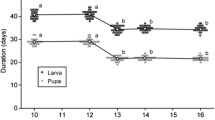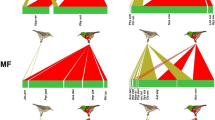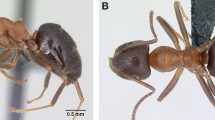Summary
Decaying petioles of giant hogweed,Heracleum mantegazzianum Sommier & Levier, are used as a breeding site by six species ofDrosophila and the drosophilidScaptomyza pallida. The most numerous parasitoid species associated with this community isLeptopilina australis. BecauseL. australis was previously unknown in western Europe, we present the characters to distinguish it form its close relativeL. clavipes. Experiments on host species selection and survival ofL. australis showed that this parasitoid mainly usesD. limbata as host. Olfactometer experiments showed thatL. australis is attracted by the odour of decaying hogweed stalks, especially when these contain larvae ofD. limbata. L. australis is also strongly attracted by the odour of stinkhorns, a habitat in which it has never been found in nature.D. phalerata is the dominant fly species in stinkhorns, and is not a host ofL. australis. We offer a possible functional explanation for this unexpected habitat choice, by showing thatD. transversa andD. kuntzei, both species found to breed in fungi, are also suitable hosts forL. australis. We also discuss habitat choice with regard to a proposed phylogeny of theLeptopilina species in temperate Europe. Finally, we discuss niche overlap ofL. australis with the otherLeptopilina species.
Similar content being viewed by others
References
Alphen JJM van, Vet LEM (1986) An evolutionary approach to host finding and selection. In: Waage JK, Greathead DJ (eds) Insect parasitoids. Academic Press, London New York, pp 23–62
Belizin VI (1966) New Armenian wasps (Hymenoptera Cynipoidea). Biol Zh Armenii 19:85–92 [in Russian]
Driessen G, Hemerik JL, Alphen JJM van (1990) Phenology and patch dynamics in a community ofDrosophila, breeding in stinkhorn (Phallus impudicus Pers.) and their larval parasitoids. Neth J Zool 40:409–427
Hummel HK, Delden W van, Drent RH (1979) Estimation of some population parameters ofDrosophila limbata v. Rosen in a greenhouse. Oecologia 41:135–143
Janssen A, Driessen G, Haan M de, Roodbol N (1988) The impact of parasitoids on natural populations of temperate woodlandDrosophila. Neth J Zool 38:61–73
Nordlander G (1980) Revision of the GenusLeptopilina Förster, 1869, with notes on the status of some other genera (Hymenoptera, Cynipoidea: Eucoilidae). Ent Scand 11:428–453
Nordlander G, Grijpma P (in press) Systematics and biology ofRhoptromeris strobigen sp. n., a parasitoid of chloropids inhabiting conifer cons (Hymenoptera: Cynipoidea: Eucoilidae). Ent Scand
Pettersson J (1970) An aphid sex attractant I. Biological studies. Ent Scand 1:63–73
Vet LEM, Lenteren JC van, Heymans M, Meelis E (1983) An airflow olfactometer for measuring olfactory responses of hymenopterous parasitoids and other small insects. Physiol Ent 8:97–106
Author information
Authors and Affiliations
Rights and permissions
About this article
Cite this article
van Alphen, J.J.M., Nordlander, G. & Eijs, I. Host habitat finding and host selection of theDrosophila parasitoidLeptopilina australis (Hymenoptera, Eucoilidae), with a comparison of the niches of EuropeanLeptopilina species. Oecologia 87, 324–329 (1991). https://doi.org/10.1007/BF00634586
Received:
Accepted:
Issue Date:
DOI: https://doi.org/10.1007/BF00634586




